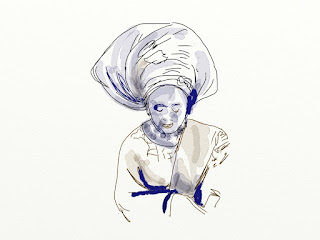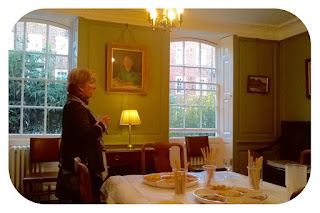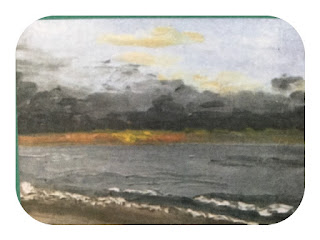I have done something so darned stupid. I’ve broken my leg!
 |
‘How did it happen? Well, it was like this…’
I creep out through the tent flap to get water from a
standpipe in the hedgerow. Early morning dew glistens on the grass around the
tent. I turn on the
tap and water splutters into my little bright
orange silicone foldable bucket (indispensable
camping essential!).
A woman stands watching me from the middle of the field. She
has a Navajo style blanket held close around her shoulders and is cleaning her
teeth. Her gaze is disturbing and impenetrable. For an unknown reason it
bothers me. Maybe she is herself trying to wake up from a deep sleep (or she couldn't sleep?) and doesn’t
realise that her emergence from slumber (or
not) is making her gape at me in such a disquieting manner?
‘I wish she'd stop staring at me,’
The bucket overflows and I go back towards our tent. My foot
slips and turns over, twisting in a rabbit hole close by a tent peg. The pail
hurls out of my grasp. I fall and hear a crack and my scream through a searing blur
of pain.
The staring woman doesn't falter in cleaning her teeth. The
bucket is bouncing yards away in a spray of dew and tap water.
Andrew dashes to my rescue and lifts me into my flimsy
camping chair that has threatened to collapse throughout the holiday. The chair
protests and strains at the joints. ‘Oh, please don't give way now’ is one of
my thoughts - another, is ‘WTF have I done?’. To my horror, my ankle appears as
though it has swallowed a tennis ball. Andrew gently places a compress (flannel soaked in cold water) upon it. “This
needs looking at,” he says with concern. “Time to phone a friend,” and he
strides away across the field with his arm raised high elevating his phone to the
Heavens. His somewhat urgent figure portraying an attitude not dissimilar to an
over dramatising Shakespearean thespian posturing on the stage making grandiose
gestures.
To get reception in this valley means a mile scramble up the
hillside or a trek into the village.
 |
| Alfriston Village |
I am left alone.
Our plans to spend the last day of our holiday visiting the
National Trust 14th century thatched Clergy House (first house acquired by the NT for £10 in 1896
by co-founder Octavia Hill) and visiting the local Rathfinny Wine Estate and buying a few
bottles are now a low priority (mind you,
I’m not convinced fine local English wine should rank as low priority in my present
condition-it might even be vital!).  |
| The Clergy House and Rathfinny Wine Estate |
Nicky warns us that the waiting time in Eastbourne Hospital
is at least four hours.
Despite the temptation to accept the kind invitation to stay
(any other time I would jump at the
chance-but, in my predicament, any form of ‘jumping’ is out of the question);
all I want to do, is leave. It must be a primitive homing instinct for when you
are injured, an inherent urge to get home-to crawl away and hide within your
own inner sanctums… to die.
Unable to help Andrew in the packing up of the tent, I sit forlorn
in my rickety ‘ready to fold up in a heap’ camping chair, thinking; that it's a
pity he has never taken his driving test.
I strap my injured foot up tight inside my walking boot.
Then drive 70 miles with a grimace and clenching of teeth at every gear change
to London (Never approach the City of
London via Blackfriars Bridge with a broken leg - they've got a new cycle path and
bus lane network that causes horrendous delays and confusion-it used to be the
best way, but not anymore-it precipitated at least thirty clenches and grimaces!).
Well, that's all for now folks. I have to pick up my
crutches and hop off till next time.
 |
| psst! Scribbles is a nickname I work under for some cartoons! |
I suspect I may now have more time now to write and post articles that I have lined up in my BACK LOG BLOG!











































